China and Covid19
Fangcang Diaries: China’s Makeshift Covid Hospitals, from Wuhan to the Future
Fangcang hospitals are here to stay as long as China sticks to its current zero-Covid path.
Published
3 years agoon
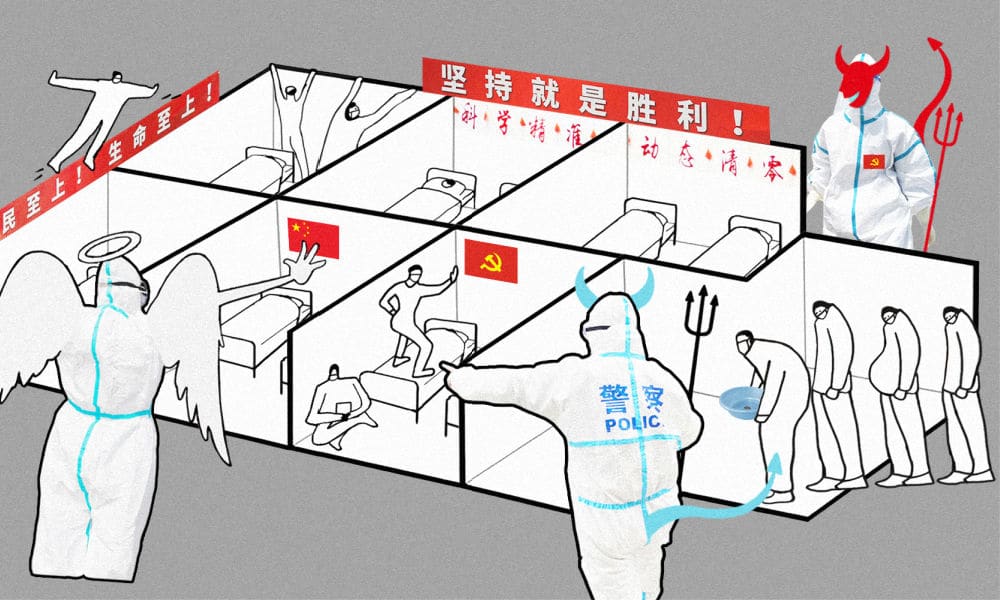
By mid 2020, many thought Fangcang, China’s Covid-19 makeshift hospitals, had become a thing of the past. Instead, they have become a part of the country’s future. Through the course of the pandemic, perceptions of China’s ‘square cabin’ Covid hospitals have drastically changed. Chinese social media users get a glimpse of life inside the Fangcang hospitals thanks to patients’ online diaries, videos, and photos.
This is the “WE…WEI…WHAT?” column by Manya Koetse, original publication in German by Goethe Institut China, visit Yi Magazin: Fangcang ohne Ende: Chinas Covid-Krankenhäuser damals und heute.
In February of 2020, the impressive construction of two enormous emergency field hospitals in Covid-stricken Wuhan captured the world’s attention. The Huoshenshan and Leishenshan Hospitals were constructed in a matter of days and combined they could take in 2,500 patients. The construction process was live-streamed by state media and sped-up drone footage of a large empty field transforming into a fully functioning hospital received millions of clicks around the internet.
Along with mass-testing and local lockdowns, the so-called ‘Fangcang’ shelter hospitals are seen as a key solution in ‘fighting Covid-19 the Chinese way’ to alleviate the pressure on public hospitals and lower Covid-19 mortality rates by quarantining and treating patients with confirmed infections.
Within a matter of 2,5 years, Fangcang emerged as a novel concept on China’s coronavirus battleground and then became a part of everyday life in a zero Covid society. Here, we will zoom in on China’s Fangcang phenomenon and changes in the public’s perceptions of it.
MORE THAN MASH: THE NOVEL FANGCANG CONCEPT
Fāngcāng (方舱) literally means ‘square cabin,’ referring to a modular or prefabricated mobile cabin hospital. Although the concept of an emergency field hospital or makeshift hospital is not new, Fangcang hospitals are labeled as a “novel public health concept” due to their specific use during China’s Covid crisis (Chen et al 2020).
Some studies say that China’s Covid-19 Fangcang hospitals were modeled after emergency cabins used during the Wenchuan and Yushu earthquakes in 2008 and 2010 (Wang et al 2020, 2). According to the biggest Chinese-language online encyclopedia, Baidu Baike, the term actually comes from the United States, where the U.S. Army first started developing such cabins – Mobile Army Surgical Hospitals (MASH units) – in the early 1950s and used them during the Korean War. The Chinese Fangcang hospital, however, is not really the same and the concept was implemented for the first time in Wuhan in February 2020.
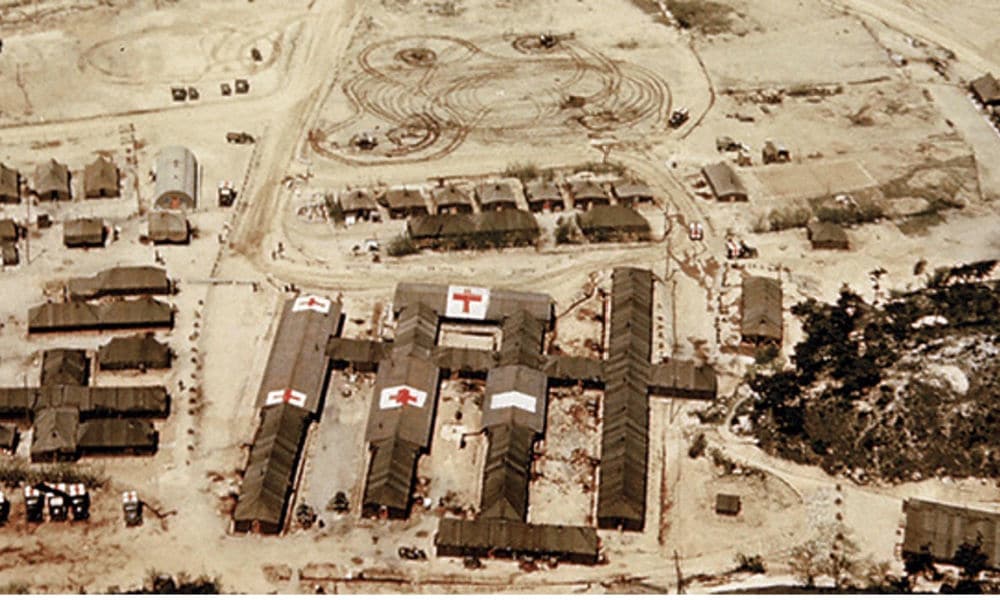
Aerial view of the American 46th MASH unit (photo by Robert L. Emanuele, published at https://bulletin.facs.org/)
In China, Fangcang hospitals are large, temporary hospitals for the isolation, treatment, and disease monitoring of Covid-19 patients with mild-to-moderate symptoms. By taking in and quarantining people who have tested positive for Covid-19, they are meant to reduce the transmission of the virus within households and communities, while also providing treatment to patients with mild symptoms (Fang et al 2020, 2). In doing so, they dramatically reduce the pressure on regular hospitals, which need their beds to solely treat patients with severe and critical conditions.
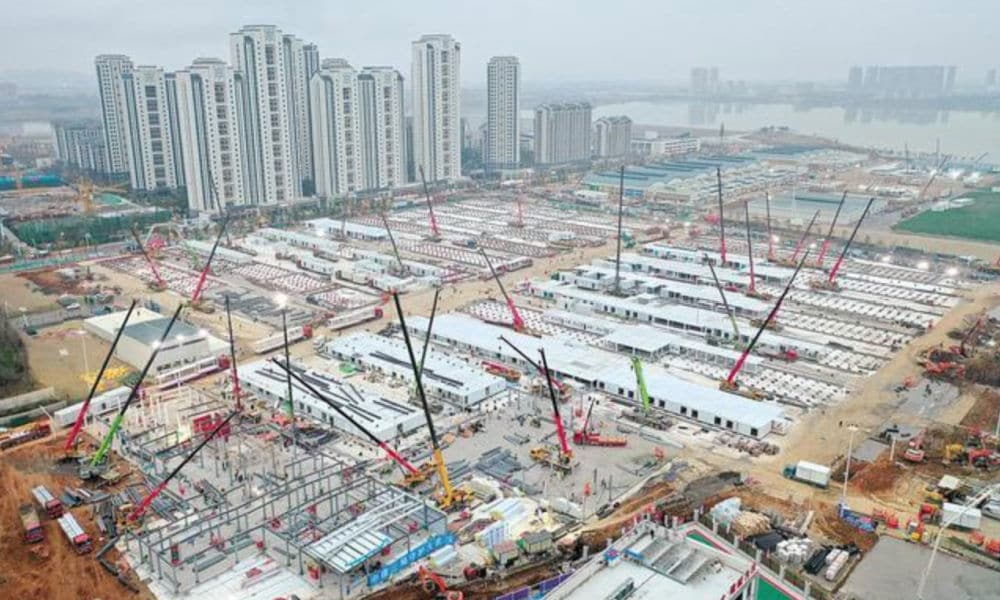
Construction of Huoshenshan Hospital, image via Sohu.com.
The 1,000-bed Huoshenshan Hospital (火神山医院) was constructed within a matter of days, starting on January 23, 2020, and ending on February 2. The first patients were admitted a day later. The construction of the 1,500 bed Leishenshan Hospital (雷神山医院) started on the 26th of January and was completed on 6 February 2020.
Many other Fangcang hospitals were not constructed like these shelter hospitals but were built by converting large (public) buildings such as exhibition centers, stadiums, or schools into healthcare facilities. In Wuhan, over a dozen more Fangcang hospitals were opened in February of 2020 to provide beds for Covid-19 patients before all being suspended on March 10 of that year when the crisis was under control.
FANGCANG ON SOCIAL MEDIA: A CHANGING IMAGE
In the early stages of the pandemic, Chinese social media users got a glimpse of life inside the Fangcang hospitals through official media videos and through footage and photos posted by people staying there. Up to the present day, patients share their quarantine experiences on social media using hashtags such as “Fangcang Diaries” (#方舱日记#).
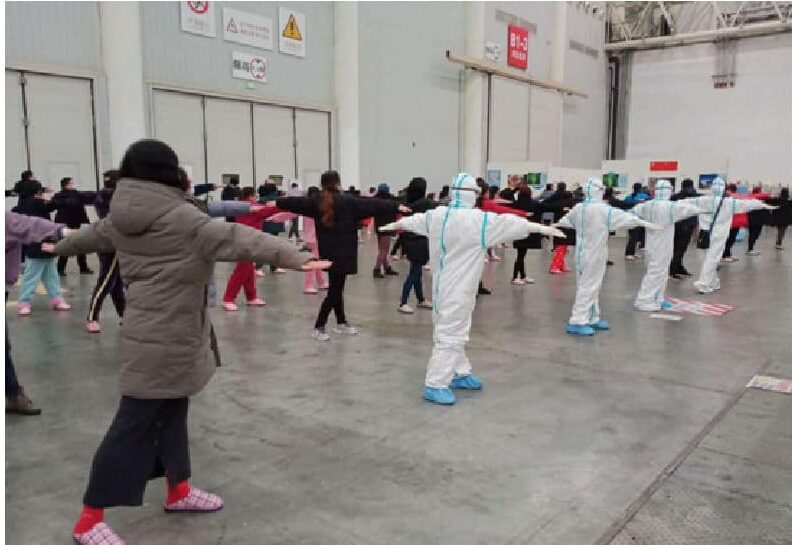
Medical workers leading a dance exercise session for COVID-19 patients at a Fangcang in Wuhan, March 2020. Photo posted on Weibo (@滨州文旅).
In the Wuhan days, there were videos of patients dancing together inside the hospitals, with people cheering on the positivity of patients and the dedication of the healthcare workers.
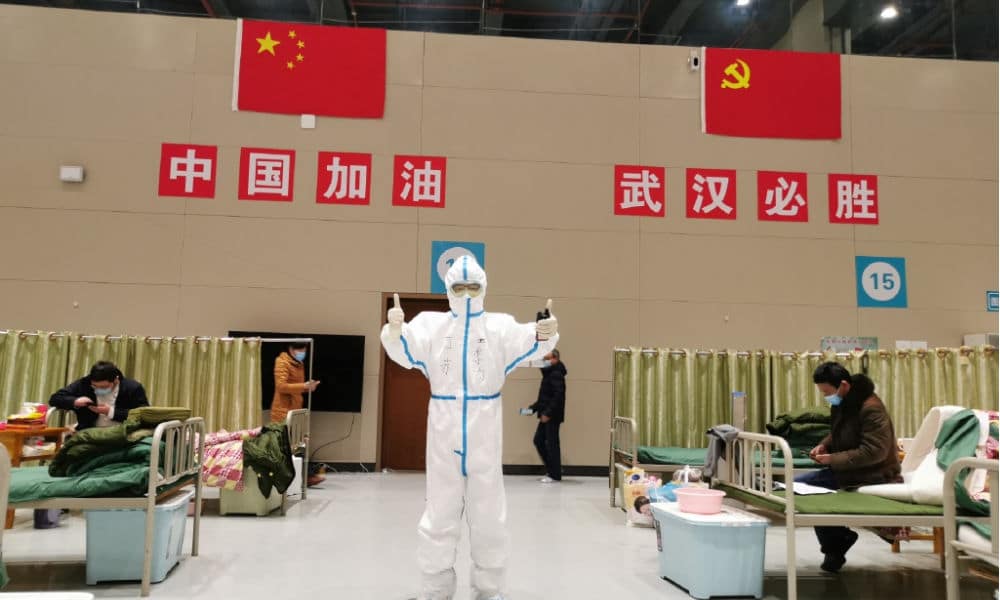
Photo posted from a Wuhan Fangcang by Weibo user (@121314人生需要转折) on February 29, 2020.
One photo of a patient reading Francis Fukuyama’s The Origins of Political Order even went viral on Weibo. Many admired the patient for reading such heavy literature during his Fangcang stay and the man became famous overnight as ‘the invincible Wuhan-er.’
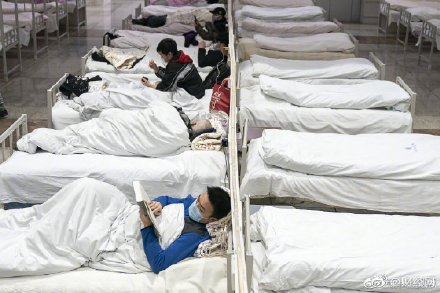
The Invincible Wuhan-er, see more here.
A young woman known as A Nian (阿念) also wrote on social media about her quarantine stay at one of Wuhan’s Fangcang hospitals in February of 2020. When her grandmother fell critically ill during her stay at the city’s Huoshenshan hospital, A Nian asked to be transferred to the same Fangcang so that she could take care of her. Despite having A Nian by her side, the grandmother passed away. A Nian’s experiences at the Wuhan Fangcang hospitals were eventually published in the book Wuhan Girl A Nian Diary (武汉女孩阿念日记). The book paints a picture of the Fangcang where resilience, warmth, and optimism dominate the overall atmosphere.
The Covid-19 outbreak in Wuhan was a national war against the virus, and the Fangcang hospitals were described and represented as a necessary and praised tool within this united fight. The medical staff members working there were the heroes on the frontline, and many social media users honored and thanked them for their efforts.
After the shelter hospitals in Wuhan gradually closed, the social media focus shifted to how the Covid crisis became a pandemic and caused chaos in the rest of the world. By April of 2020, Wuhan had returned to a state of normalcy, and schools across the country reopened. When Huoshenshan and Leishenshan closed their doors, Fangcang soon seemed to become a thing of the past.
Although there were local outbreaks of Covid-19 in China throughout 2020 and 2021, the Fangcang hospitals did not really return to the public spotlight until Xi’an saw cases spike in late 2021 and early 2022, with the city becoming the epicenter of the biggest Covid outbreak and lockdown since Wuhan.
By January of 2022, the city of Xi’an had started to construct large sites for isolation of people who tested positive for Covid-19, in addition to designated hospitals. Besides ‘Fangcang,’ these were also called ‘Centralized Isolation Points’ (集中隔离点).
As later explained by Dr. Wu Jinglei, director of Shanghai Municipal Health Commission, Fangcang hospitals can also be used as ‘Isolation Points.’ The two are the same but using ‘Isolation Point’ instead of ‘Fangcang Hospital’ emphasizes the need to also isolate and observe patients who are asymptomatic at these health locations, besides treating those with mild-to-moderate symptoms. Later on, these locations also started to be referred to as ‘Fangcang Isolation Points’ (方舱隔离点) or ‘Isolation Fangcang’ (隔离方舱).
One story that attracted major attention on Chinese social media and indicated changing perceptions of the Fangcang phenomenon was the midnight eviction of residents of the Xi’an Mingde 8 Yingli community (明德八英里小区) in Xi’an. Just after midnight on January 1st of 2022, residents received news that they would be transferred by buses, and quarantined away from their compound due to new infections in their proximity.
Residents voiced their concerns on social media about the incident, saying they were unsure of where they were heading, and that they were put in buses together for hours until being driven off to a remote Fangcang without proper supplies. The term ‘bèi lāzǒu’ (被拉走) was used, ‘being dragged away.’
Old people, young children, and pregnant women were among those being taken away for quarantine without being provided with the things they needed, and without any measures to protect them against the dangers of infection. An image of an old man with a walking cane standing in line to be taken away for quarantine went viral online as many worried about his wellbeing. He was seemingly all alone and did not seem to have any luggage or food supplies with him.
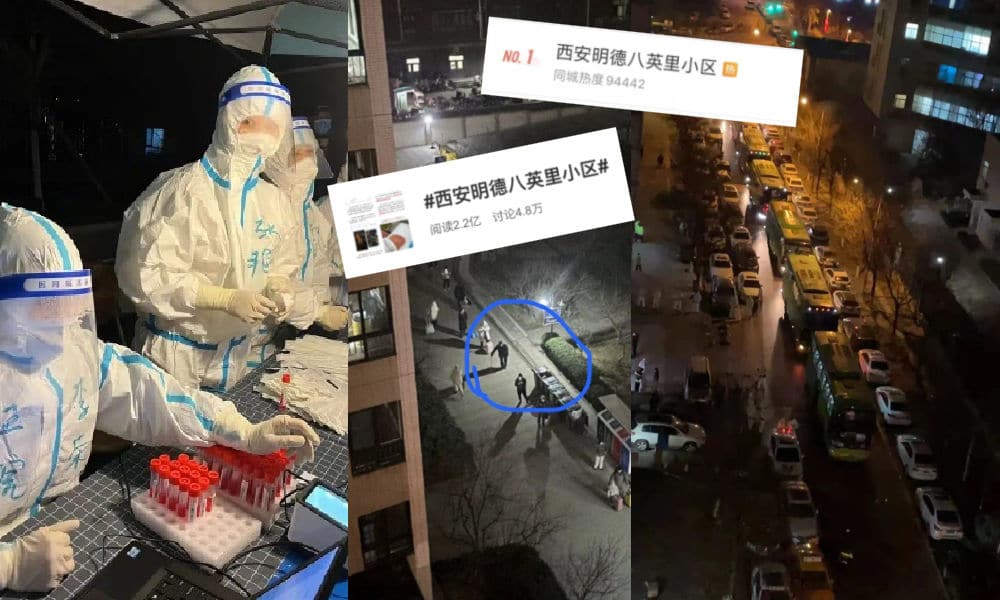
Seeing photos of old buildings without proper facilities being turned into Fangcang, many residents wondered what the point of this kind of isolation was. One popular post by a Weibo user nicknamed ‘In Between Memories’ from January 2nd of 2022 said:
“I don’t understand why negative-tested families should be dragged away for isolation? Isn’t isolation at home also isolation? The Fangcang hospitals were built to focus on treating the mildly ill, separately from the seriously ill. But nowadays, after discovering one positive case, Xi’an wants to pull away the entire neighborhood to a centralized quarantine with poor conditions – even if everyone has already been in home quarantine for over a week. Is this all just so that Xi’an can say it has zero infections while ignoring the scientific basis that many families tested negative multiple times? While disregarding the special needs of families with elderly, young, sick, disabled, and pregnant people? Before transferring people, you never provided them with a policy basis, nor was there any warning or reminder given to the citizens of Xi’an that you would implement [this policy] on the spot in the middle of the night. Now that everyone is at risk, perhaps some will support this, hoping that there can be zero cases within the community in a time frame of three days. But there are more residents who are only worried that the next one to be dragged away will be them. After all, we will be taken away even if we stay well at home and test negative ten times for the nucleic acid test, what about the elderly and our children, what about our pets? No one cares, they only care about their hard target to clear the city of Covid within three days.”
Within three weeks of lockdown, Xi’an was the first city to have so many patients admitted to Isolation Points: nearly 50,000 people were isolated at 443 different Fangcang quarantine locations across Xi’an (Southern Weekend 2022).
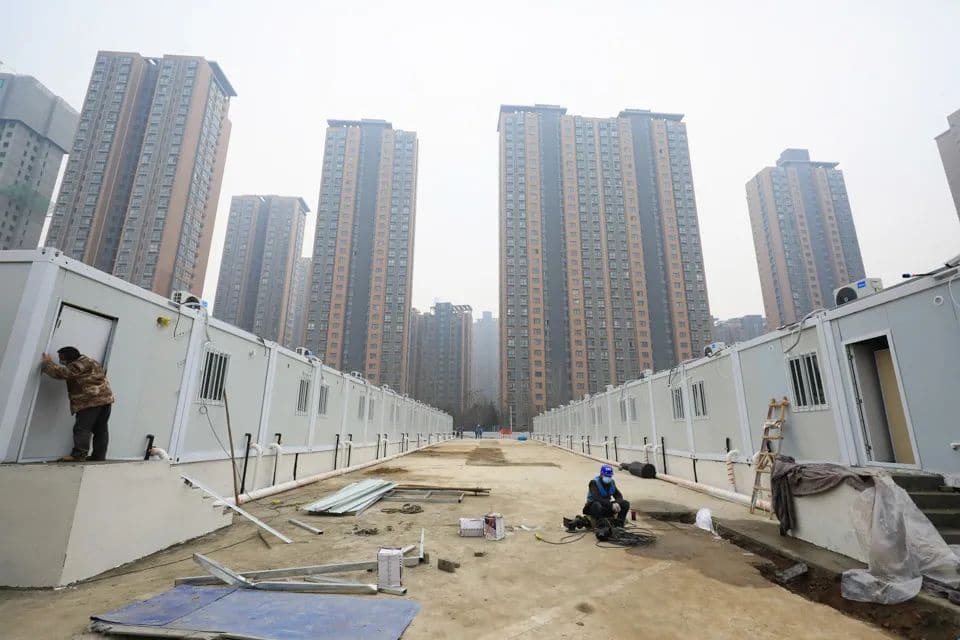
January 5 2022, a Fangcang or Isolation Point with over 1000 separate isolations rooms is constructed in Baqiao District of Xi’an (Image via Renmin Shijue).
The fears of being taken away to Fangcang hospitals and Isolation Points also became a reality for Shanghai residents after an unprecedented Covid-19 spike in the city, starting in March of 2022. As the city entered a phased lockdown, photos and videos of a local quarantine site where babies and small children were kept in isolation – separated from their parents – went viral on Chinese social media.1
Not long after, patients at Fangcang hospitals started posting on social media about their experiences, complaining that there was a lack of basic supplies, that they were not given the medicine they needed, and that vulnerable patients were left to their own devices without proper care.
As the Covid-19 cases continued to spike throughout March and April, videos also started surfacing showing chaotic scenes at some Fangcang sites in Shanghai where patients were fighting over supplies such as blankets, water, and food, some crying when they were unable to get anything but some bottles of water – or nothing at all.
The apparent disorganization at quarantine facilities from the city’s Pudong to Minhang Districts triggered discussions on Chinese social media about why asymptomatic patients were taken off to these ill-equipped centralized Fangcang locations at all and why they were not allowed to isolate at home instead.
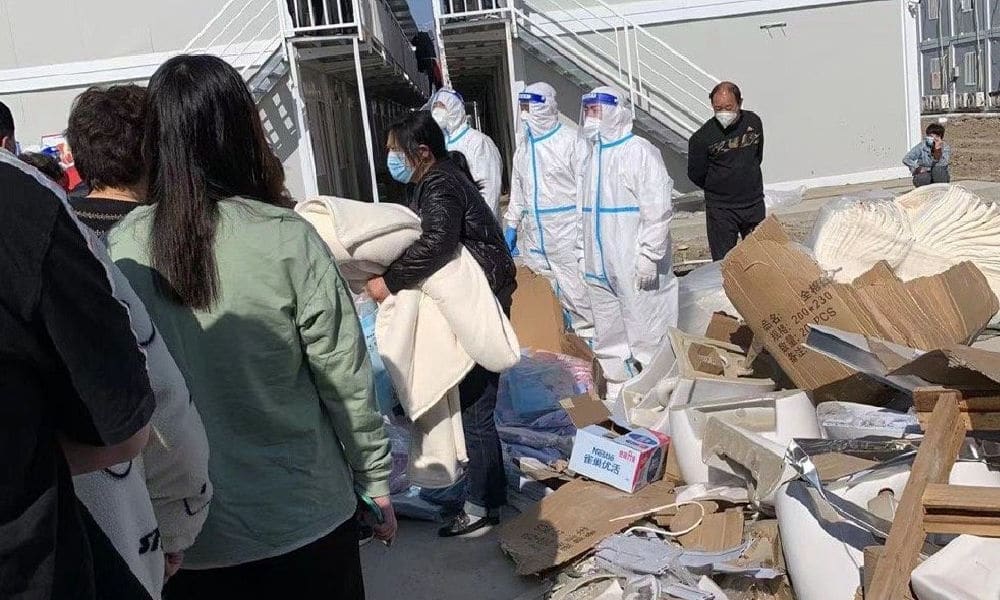
Chaotic situation at a quarantine location in Shanghai’s Pudong in early April 2022 (video).
One Weibo user wrote in April 2022:
“They took us to an isolation site. If the conditions had just been a bit better, we’d be okay with it, but this is just unimaginable. These are the facts. Over 800 people have entered this facility since April 9, their ages varying from seventy or eighty years old to babies just a few months old. 1. Inside the factory building, there are plank beds without mattresses, there are no people to clean. 2. There is no supervisor, we need to fight over our food. 3. There are not enough supplies, not even enough toilet paper. 4. 80% of the toilets are clogged, there’s nobody to clean them. 5. There are no doctors and nobody to take care of patients with a fever. 6. There is no one to dispose of the garbage. 7. The weather’s hot, but there’s no place to shower or change clothes.”
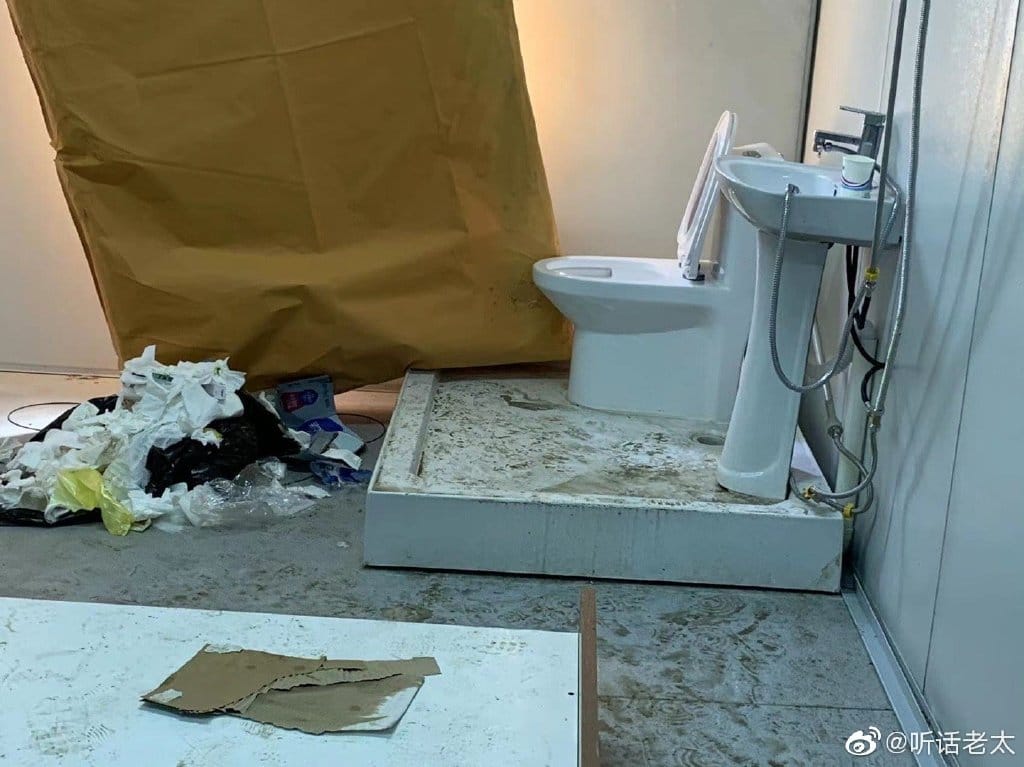
Patients shared a photo of the toilets at one Pudong quarantine location (more here).
Stories also started coming out of patients being taken away to Isolation Points many days after they had first tested positive for Covid. By the time they were finally taken away for quarantine, they had recovered and tested negative for Covid-19, yet still had to go and stay together with patients testing positive.
To create more beds for patients, Shanghai opened China’s largest-ever Fangcang hospital on April 8 at the National Exhibition Convention Center. This Fangcang, built by the same people who had helped build Huoshenshan and Leishenshan in Wuhan, had a capacity of 50,000 beds for Covid-19 patients.
These bigger, modern, and central Fangcang locations are generally neat and orderly, providing regular meals and medicine, as well as offering various activities or even setting up classrooms for quarantined students.
But photos, footage, and online diaries posted on social media exposed the stark differences in living conditions between different Fangcang hospitals. By late April of 2022, patients staying at one Fangcang location in the city’s Putuo District – an office building converted into a makeshift hospital – complained about the crowded living conditions, the lack of washing rooms and showers, and the inadequate supply of food and drinking water. At other facilities, patients posted videos of water pouring into the building after heavy rain.
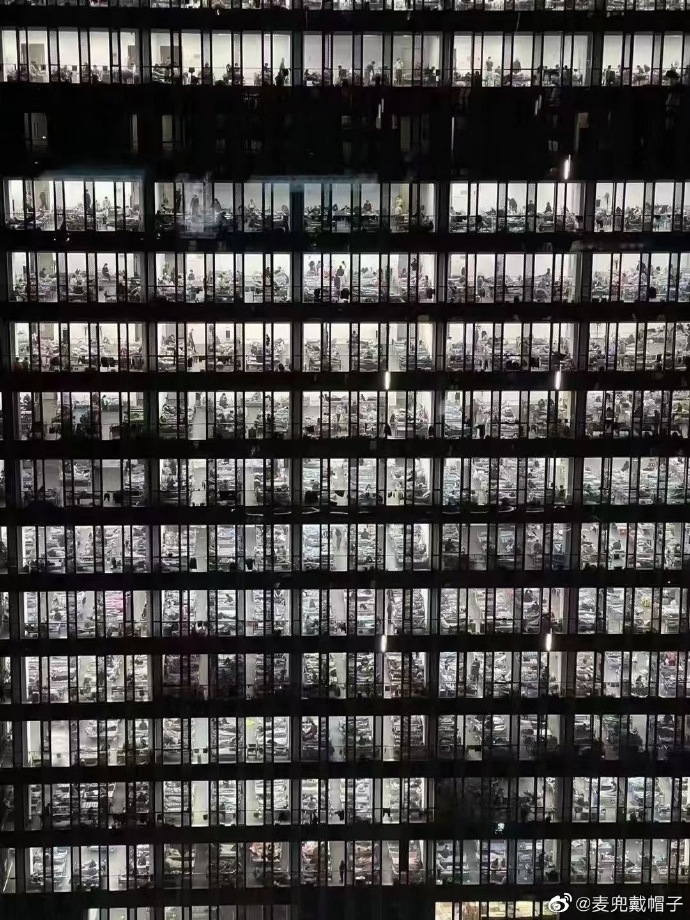
Wide-angle view of the Shanghai office buildings that have been converted to Fangcang hospitals (What’s on Weibo).
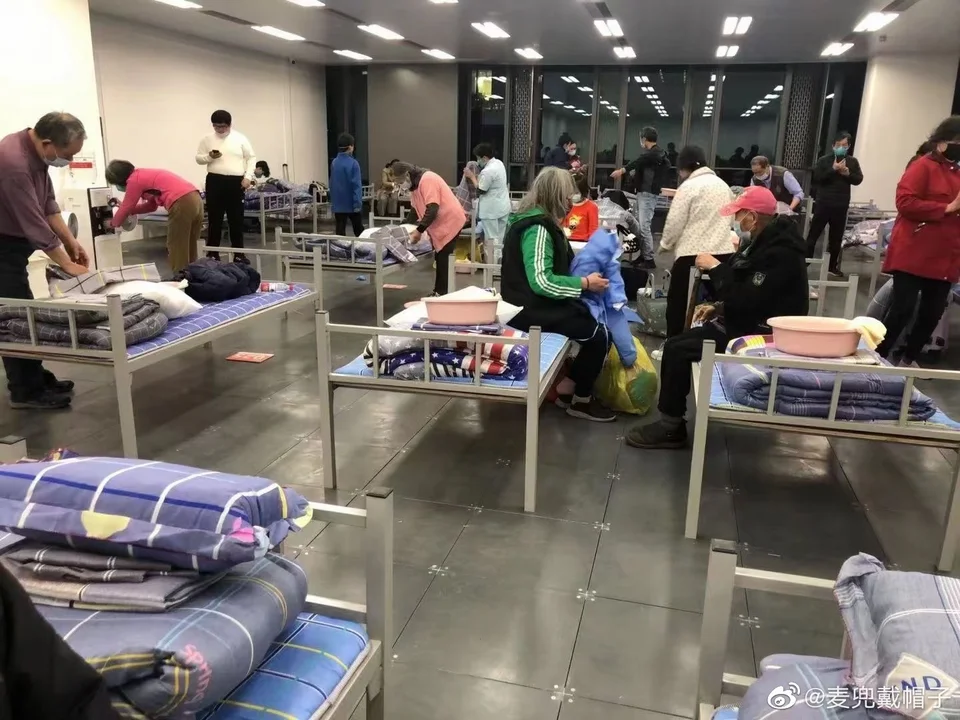
Inside the office converted into Fangcang, photo via Weibo.
From Wuhan in 2020 to Shanghai in 2022, the public perception of the Fangcang phenomenon in China changed dramatically. While it was initially seen as an effective, efficient, and celebrated response to the outbreak of Covid, many Shanghai-based residents, during the peak of the city’s Covid crisis, feared the Fangcang more than the virus itself, as stories about overcrowded, disorganized and unequipped facilities kept surfacing online.
THE FUTURE OF FANGCANG
By mid-May of 2022, after seeing over 60,000 confirmed Covid-19 cases in total, Shanghai retired half of its Fangcang locations due to rapidly declining cases. Nevertheless, the restrictions to keep Covid under control are still stringent.
As Chinese leadership remains adamant on sticking with its zero-Covid strategy, state media emphasize the need to uphold the mandatory quarantine system as part of this public health policy, which basically means the country will not opt to ‘live with the virus’ but instead will continue to implement strict measures to eliminate a Covid outbreak as fast as possible once it emerges.
Fangcang are here to stay as long as China stays on its current zero-Covid path. The country’s top epidemiologist Liang Wannian (梁万年) maintains that patients need to be isolated at a centralized location because they can be easily monitored and treated that way, while also minimizing the risks of them spreading the virus to others in their household or community.
In preparation for potential future outbreaks, cities across China are building new Fangcang or are improving existing ones. Authorities are making sure that the country is ready to manage more local outbreaks, avoiding messy Fangcang scenes like the ones in Xi’an or Shanghai.
On May 13, China’s National Health Commission called on all provinces to build or renovate city-level Fangcang hospitals, and to make sure they are equipped with electricity, ventilation systems, medical appliances, toilets, and washing facilities.
The country-wide Fangcang preparation plan is now in full swing. In Zhengzhou, for example, construction workers are building a new Fangcang from the ground up. The city of Zhoukou recently issued a promo video on Weibo showing off their local brand-new Fangcang location with 356 private rooms equipped with air disinfection systems, private showers, and free Wi-Fi. Meanwhile, Shanghai even introduced its first Fangcang location for pets.
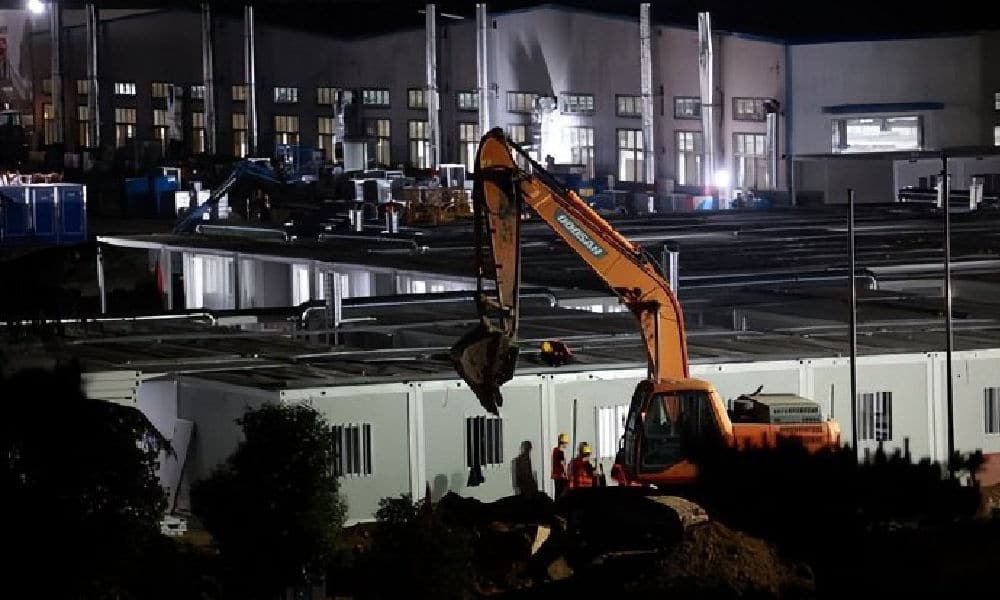
Zhengzhou’s new Fangcang, construction work in mid-May 2022 (Weibo via @顶端新闻).
When it was announced that China would withdraw as the 2023 Asian Cup host due to the pandemic, netizens joked that the stadiums constructed for the sports event could now be turned into Fangcang instead.
“The Fangcang will become a regular facility in the next few years,” some social media users commented. Others wrote: “This is good news. It’s better to be prepared for what’s coming,” and: “Better to prepare to build the Fangcang now than to prepare to build our future graves.”
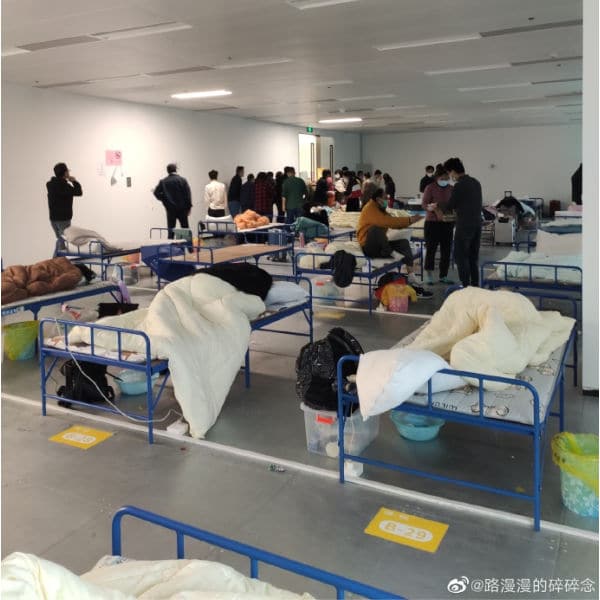
Weibo user sharing photo from one Shanghai Fangcang (@路漫漫的碎碎念)
Generally, despite worries over a lack of medical care and supplies at facilities, many people do support the idea of their cities being prepared for an immediate Covid response once it’s necessary. “I don’t get why people are being negative about building new Fangcang,” one Weibo user from Hebei Province writes:
“People think that they should stay home if they get infected but want other people to quickly go away to a Fangcang hospital if they’re sick. Our little town is now also building a Fangcang, and I think it’s a good thing. Before, there were too many infections in the neighboring village, and they took them for isolation to the hotel in our city center and all stores in the vicinity had to close. (..) It was scary, people didn’t want to visit the center anymore. Now, they’re building a Fangcang at the town border, away from the people, and it’s a relief for all of us.”
Meanwhile, Fangcang patients keep sharing their journals online. “Today is day seven for me,” one Shanghai resident wrote on Weibo: “I finally had an egg for the first time here. I’ve been constipated all week (..) This morning, I heard I meet the conditions to be discharged [two negative tests in a row], but due to the lack of capacity I’m still waiting, and it might still take two or three more days before I get to go home.”
“It’s day twelve. I can’t wait until I’m released from ‘prison’,” one person wrote.
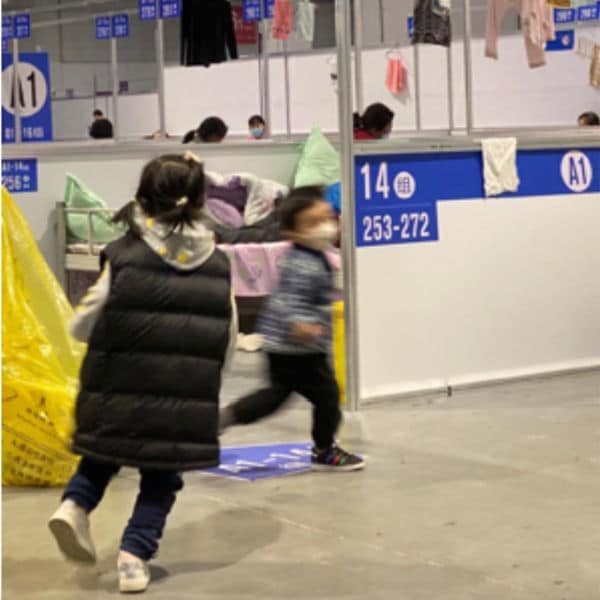
Kids playing inside a Shanghai Fangcang Isolation Point, pictured shared on Weibo.
“It’s my first night at the Fangcang,” one Weibo user writes in another online ‘Covid journal’: “There’s too much light and noise, and my dad and I took turns in waking up. Eventually, he decided to get up, thinking it was 5 am, until we discovered it was just past 2 am. I felt light-headed as I headed to the bathroom.”
One patient at another Shanghai Fangcang writes: “My stay at the Fangcang is better than I had expected. I am sleeping better than at home and don’t have to think about what I am going to eat. But there are many elderly people inside here, and I see them suffering. I’m not sure if this policy really helps them.” They also write: “I’d better record all of this. I think this is going to be an experience I’ll remember for the rest of my life.”
By Manya Koetse
Follow @whatsonweibo
1 On April 6, 2022, Shanghai changed the policy and announced that parents can apply to accompany their children during central quarantine after signing an agreement, regardless of whether they’ve tested positive for the virus or not.
References (other sources linked to inside the text)
Chen, Simiao Chen, Zongjiu Zhang, Juntao Yang, Jian Wang, Xiaohui Zhai, Till Bärnighausen, Chen Wang. 2020. “Fangcang Shelter Hospitals: A Novel Concept for Responding to Public Health Emergencies.” The Lancet, April 2 https://www.thelancet.com/journals/lancet/article/PIIS0140-6736(20)30744-3/fulltext [May 12, 2022].
Fang, Dongpin, Shengjie Pan, Zaishang Li, Ting Yuan, Benran Jiang, Di Gan, Bai Sheng, Jing Han, Tao Wang, Zhongmin Liu. 2020. “Large-Scale Public Venues as Medical Emergency Sites in Disasters: Lessons from COVID-19 and the Use of Fangcang Shelter Hospitals in Wuhan, China.” BMJ Global Health 5: 1-7.
Luo, Hanbin, Jiajing Liu, Chengqian Li, Ke Chen, Ming Zhang. 2020. “Ultra-Rapid Delivery of Specialty Field Hospitals To Combat COVID-19: Lessons Learned from the Leishenshan Hospital Project in Wuhan.” Automation in Construction 119 (103345): 1-10.
Southern Weekend 南方周末. 2022. “The Largest Centralized Quarantine: 49,678 People in nearly One Month, What Has Xi’an Invested 最大规模集中隔离:近一月49678人,西安付出了什么” [In Chinese]. Sina News, January 13 https://news.sina.cn/2022-01-13/detail-ikyamrmz4934227.d.html [May 13].
Wang, Ke-Wei, Jie Gao, Xiao-Xiao Song, Jiang Huang, Hua Wang, Xiao-Long Wu, Qin-Fang Yuan, Xiao-Shan Li, Feng Cheng, Yang Cheng. 2020. “Fangcang Shelters Are a One Health Approach for Responding to the Covid-19 Outbreak in Wuhan, China.” One Health 10 (100167): 1-6.
Featured image by Ama for Yi Magazin.
This text was written for Goethe-Institut China under a CC-BY-NC-ND-4.0-DE license (Creative Commons) as part of a monthly column in collaboration with What’s On Weibo.
Spotted a mistake or want to add something? Please let us know in comments below or email us. First-time commenters, please be patient – we will have to manually approve your comment before it appears.
Manya is the founder and editor-in-chief of What's on Weibo, offering independent analysis of social trends, online media, and digital culture in China for over a decade. Subscribe to gain access to content, including the Weibo Watch newsletter, which provides deeper insights into the China trends that matter. More about Manya at manyakoetse.com or follow on X.
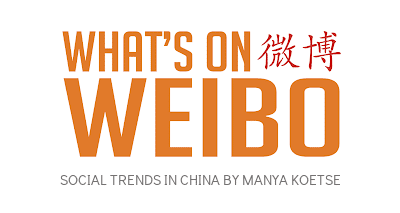
China and Covid19
Weibo Watch: Small Earthquakes in Wuhan
How Wuhan is shaking off its past with a new wave of innovation, the hot topics to know, and the Weibo catchphrase of the week: ‘the Three Questions of Patriotism.’
Published
5 months agoon
September 27, 2024
PREMIUM NEWSLETTER | ISSUE #37
Dear Reader,
“Wuhan Earthquake” (#武汉地震#) momentarily became the number one trending topic on Weibo this Friday night, after residents of Jiangxia District reported feeling their homes and buildings shake. “Was there an earthquake, or am I drunk?” some wondered.
I also felt a bit tipsy in Wuhan this month. Neon signs, dancing livestreamers, flying drones, bustling night markets, and holographic lights. On my first night in Wuhan, the lights made me dizzy and I discovered that the city was nothing like I had imagined.
Until now, I couldn’t help but associate Wuhan with the wet market, crowded fever clinics, and China’s first Covid hospitals. As the world watched the pandemic unfold in 2020, Wuhan became instantly famous as an early epicenter of the Covid-19 crisis. It became known as the quarantined city, the city of Dr. Li Wenliang, and the city of the “invincible Wuhan man.” At the time, it seemed like such a monumental event that Wuhan would not recover anytime soon, even after enduring the worst peak of Covid.
Now, over four years later, everything feels different. I felt a rush of energy as I strolled through the lively streets. It was evident that Wuhan is much more than the city that gained global notoriety as the pandemic hotspot. Beyond its vibrant atmosphere, it is making international headlines for its leadership in autonomous driving, having emerged as the world’s largest testing ground for self-driving cars, particularly in unmanned ride-hailing services.
Baidu’s Apollo Go, referred to as Luobo Kuaipao (萝卜快跑) in Chinese, is the driving force behind the robotaxi revolution in Wuhan. Since their arrival earlier this year, they have become a hot topic on Chinese social media, and I was eager to experience it for myself.
(Brief explainer: Luóbo (萝卜) means radish or turnip in Chinese, but when pronounced, it sounds similar to “robo.” Kuàipǎo (快跑) translates to “run fast.” Combined, it creates a playful name that can be interpreted as “Radish Runs Fast” or “Robo Go.” I’ll use ‘Luobo’ here, as it is the most common way to refer to Apollo Go in China and has a cute sound.)
In the areas where the robotaxis operate, people already seem to have become accustomed to the driverless ‘Luobo.’ During a 1.5-hour ride in the unmanned taxi—I took a long journey and then needed to return again—I was surprised to see so many of them on the road. Other drivers, motorcyclists, and passengers didn’t even bat an eye anymore when encountering the new AI taxi.
Currently, there is an active fleet of 400 cars in Wuhan, and Baidu plans to expand this to 1,000 in the fourth quarter of this year. Although these taxis still comprise only a fraction of the city’s entire taxi industry, their impact is noticeable on the roads, where you will inevitably encounter them. I stood at one drop-off point near an urban shopping center for at least forty minutes and witnessed passengers being dropped off continually, with some proceeding their journeys into areas where Luobo doesn’t operate by calling the ride-hailing service Didi from there.
As for the experience itself, it was thrilling to see the steering wheel move with no driver in the front seat. I was surprised at how quickly I adapted to something so unfamiliar. It’s incredibly comfortable to have a car to yourself—no driver, no worries—while you choose your own music (and sing along), set the air conditioning, and relax as the Luobo navigates the traffic.
Even inside the vehicle, Baidu emphasizes the safety of their self-driving cars, providing information about how Apollo Go has accumulated over 100 million kilometers of autonomous driving testing without any major accidents, thanks to a strict safety management system.
If you close your eyes, the experience feels like riding with a regular driver. Luobo speeds up, slows down, and occasionally makes unexpected maneuvers when a car or bike suddenly approaches. It ensures there’s enough space between itself and the car in front. While I can’t say that merging onto the highway or encountering unexpected traffic situations didn’t feel a bit scary, I soon felt at ease and came to rely on the technology.
That said, there are still bumps in the road. Luobo has often been ridiculed on Chinese social media for getting stuck at a green light, stopping for a garbage bag, or struggling to make a U-turn. While riding and observing the robotaxis in Wuhan, I noticed plenty of honking and road rage as Luobo chooses safety first, often appearing sluggish, earning them the nickname ‘Sháo Luóbo’ (勺萝卜/苕萝卜, “silly radish”).
While Luobo might still have its silly moments, it is a serious part of the future. Already, it is popular among commuters for its low cost, privacy, and convenience.
After spending an entire morning riding and watching the Luobos, I excitedly felt like I had experienced a glimpse of the future. Right now, Luobo Kuaipao operates in various cities across China, including Beijing, but it’s still in the testing phase there—none of my friends from Beijing have ever seen or taken one yet. However, this will likely change soon, heavily relying on policy support.
That night, I spoke to a young local in a busy commercial area near my hotel. Like many residents, he was curious about where I came from and what I was doing in Wuhan. (During the four days I spent there, I noticed very few foreign tourists.) We briefly discussed the pandemic; he reflected on the difficulties it brought but treated it as something from the past—just another bump in the road in the city’s long history.
Instead of dwelling on the pandemic, our conversation focused on the future: Wuhan’s robotaxis, his confidence in China’s technology, and the rising importance of his country on the geopolitical stage. He was just one of several young people I spoke to, from shopkeepers to students, who seemed very focused on China’s growth and development and how its technological advancements reflect its position in a world where the U.S. is no longer leading.
When it comes to China’s driverless innovations, they are shaking the foundations of transportation like an earthquake. Besides Apollo Go, companies like Pony.ai (小马智行), WeRide (文远知行), SAIC Motor (上汽集团), AutoX (安途), FAW (一汽), Changan Automobile (长安汽车), BYD (比亚迪), Yutong (宇通), and many other industry players are also working to realize driverless passenger cars, shuttle services, freight trucks, delivery vehicles, public transport buses, and much more.
What we’re witnessing in Wuhan is merely a glimpse into a future under construction, actively promoted by Chinese state media. Over the past week alone, CCTV featured Luobo Kuaipao in three segments as a key example of China’s new technological advancements and the national strategy to build a strong tech-driven economy.
As I left Wuhan in a traditional taxi, I suddenly felt like a time traveler. Wuhan was the birthplace of the 1911 revolution and will also appear in foreign history books as the initial epicenter of the Covid-19 pandemic. Now, it is at the center of an international robotaxi revolution, and it won’t be the same the next time I return.
While my friendly elderly driver—I estimated him to be in his late 50s—honked at other cars, I realized he had witnessed many other revolutions, including the Cultural Revolution as a young boy, the economic reforms, and the major social changes of the 1980s, as well as the digital revolution of the 2000s. With the growth of Wuhan’s robotaxi fleet, his job might be affected, adding another tremor to his city and his life—though he may already be retired by then.
As he helped me with my luggage and wished me a safe trip home at the Wuhan Hankou Station, I couldn’t help but feel nostalgic about how everything always changes and gets shaken up as we move forward into a future driven by technology.
As for Friday’s earthquake in Wuhan—it turns out it was a 1.6. Despite the online interest in the topic, it means virtually nothing in a city where things of much greater magnitude are happening.
If you’d like to know more about my experiences and the slight setback I encountered while searching for Wuhan’s robotaxis, check out the short videos I made here:
Part 1 (also on Instagram)
Part 2 (also on Instagram).
Best,
Manya Koetse
(@manyapan)
What To Know
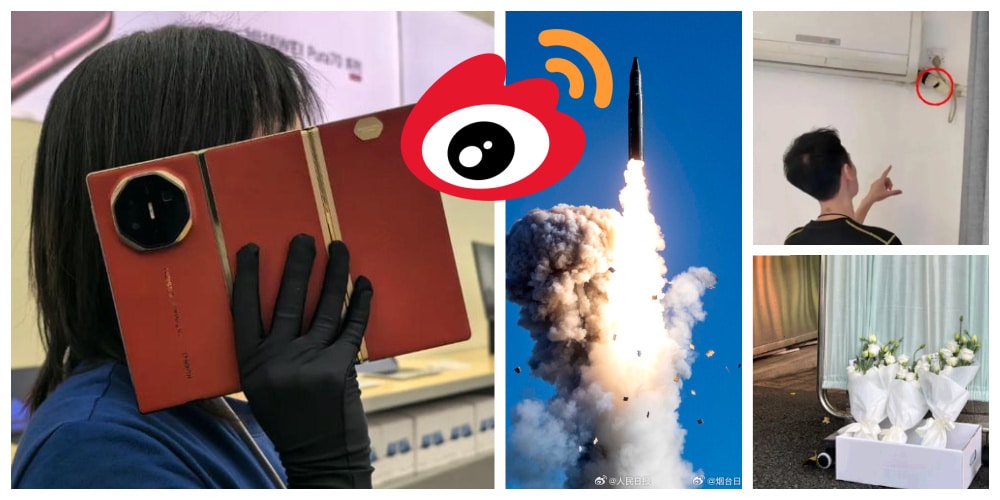
🚀 China’s First Intercontinental Ballistic Missile Test-Launch Since 1980
On the morning of September 25, China announced a successful test launch of an intercontinental ballistic missile (ICBM) carrying a ‘dummy warhead’ into the Pacific Ocean. This marked the first ICBM launch in decades, described by official media as part of routine annual training.
The People’s Daily Weibo account of the Communist Party shared a video of the People’s Liberation Army (PLA) announcing the successful test launch, accompanied by suspenseful and patriotic music, specifically the “March of the Steel Torrent” (钢铁洪流进行曲) (see video). This launch quickly became a trending topic (#我军向太平洋发射洲际弹道导弹#). While Chinese state media claimed that Beijing informed relevant countries in advance, Japan stated that it did not receive any prior notice, further heightening tensions between China and Japan.
🇯🇵 Aftermath of Japanese Schoolboy Stabbing
The incident in which a Chinese man fatally stabbed a ten-year-old Japanese schoolboy near the Shenzhen Japanese School on September 18 has become a widely discussed topic this month. The attacker, a 44-year-old Chinese national, was immediately arrested. However, discussions about the stabbing are ongoing, as it has sparked a wave of anger in Japan, where critics argue that anti-Japanese sentiments in China are fueled by official media and national education.
Meanwhile, China and Japan have effectively resolved their diplomatic dispute regarding the Fukushima water discharge, with some suggesting a connection between the two events. China’s Foreign Ministry spokesperson Mao Ning (毛宁) stated on September 20 that the issues are not related (#中日共识与日本男童遇袭无关#). Beyond the geopolitical implications, the international media coverage of the stabbing incident has also provoked anger on Chinese social media, where many netizens reject the supposed negative portrayal of China. The topic is quite sensitive and continues to face significant censorship online.
📱 Huawei Trifold Phone
The launch of Huawei’s ‘trifold’ phone earlier this month generated significant excitement in China, with many believing that Huawei—and, by extension, China—is now at the forefront of innovation in the folding screen smartphone race. The Mate XT is the first triple-folding screen phone, leading some top commenters to proclaim, “Huawei’s innovation capability is truly the best in the world. While other manufacturers are still researching foldable phones, Huawei has already released the trifold.”
During my travels in China over the past few weeks, I visited several Huawei stores, but unfortunately, the trifold was never on display; it’s available only by reservation and has allegedly garnered millions of pre-orders, despite its hefty price tag of CNY 19,999 (USD 2,850). There’s also been some lighthearted banter surrounding the phone, including a viral post that humorously depicts what it looks like when you make a phone call with the screen unfolded (it looks ridiculous), and a user who taped two phones together to create a sixfold.
👴 Retirement Age Discussions
News came out last week that China will raise its retirement age for the first time since the 1950s. China’s current retirement ages are among the world’s lowest. Facing an aging society and declining birth rates, the ages will now be increased in a step-by-step implementation process: 50 to 55 for women in blue-collar jobs, 55 to 58 for females in white-collar jobs, and 60 to 63 for male workers.
This change, set to take effect on January 1, 2025, has already sparked considerable discussion this year after experts proposed the adjustment. A related hashtag has garnered over 870 million views on Weibo (#延迟法定退休年龄改革#), where many users expressed their dissatisfaction with the change. “Great, I’ll get to retire in September of 2051 now,” one young worker wrote. “We start studying earlier and retire later; how can we keep up with this?”
📷 Hidden Hotel Cameras
After a Chinese blogger known as “Shadows Don’t Lie” (@影子不会说谎) recently discovered and exposed hidden cameras in the rooms of two guesthouses in Shijiazhuang, he faced significant intimidation and threats from the owners and employees, who accused him of staging the situation for attention.
However, the situation turned out to be real, and local police arrested multiple suspects responsible for installing these cameras inside these hotel rooms, which are often rented by young couples for romantic short stays. The suspects reportedly did not know the guesthouse owners and had secretly set up the cameras to profit illegally. This incident, which continues to generate discussion online, has heightened public concern over privacy protection and the integrity of the guesthouse industry, particularly as this is not the first time such issues have been revealed.
Weibo Word of the Week

The Three Questions of Patriotism
Our Weibo word of the week is 爱国三问 (àiguó sān wèn), which translates to “The Three Questions of Patriotism.” This phrase has recently gained attention on Chinese social media as it was highlighted and propagated by official media channels.
The three questions are:
1. Are you Chinese? (你是中国人吗)
2. Do you love China? (你爱中国吗)
3. Do you wish China well? (你愿意中国好吗)
These questions were originally posed in 1935 by Zhang Boling (张伯苓), the first president of the renowned Nankai University (南开大学) in Tianjin.
Today, they are being revived on Chinese social media through various videos released by official channels.
One notable video is part of a new online series produced by state media titled “Great Educators” (大教育家), which features reenactments of speeches by prominent Chinese educators. In this series, Zhang Boling’s speech, portrayed by actor Wang Ban (王斑), emphasizes the importance of unity in tumultuous times.
Rather than dwelling on differences, Zhang urged people to recognize their shared identity: they are all Chinese, they love China, and they all aspire for the country’s prosperity.
Another video features Nankai University’s current president, Chen Yulu (陈雨露), addressing students during a large event on September 21st. In his speech, Chen reiterates the three famous questions, prompting the hundreds of students in attendance to respond enthusiastically: “We are [Chinese]!” “We love [China]!” “We wish [China well]! We want China to be strong and prosperous!” This response is followed by enthusiastic applause.
Additionally, another video from the same day features a meeting between Chen Yulu and an AI version of Zhang Boling, digitally resurrected to address the students and celebrate the start of the new school year. During this ‘virtual dialogue,’ Chen informs Zhang that his ‘Three Questions of Patriotism’ have become a cherished tradition at Nankai’s annual opening ceremony.
According to Chinese state media, the students’ responses to these three questions illustrate how contemporary Chinese youth are aligning their personal aspirations with national progress. This alignment is seen as a revival of the patriotic spirit that Zhang Boling instilled in students during wartime. However, the current ‘revival’ of this sentiment appears to be largely reflected across various official channels, with limited engagement from ordinary netizens.
This is an on-site version of the Weibo Watch newsletter by What’s on Weibo. Missed last week’s newsletter? Find it here. If you are already subscribed to What’s on Weibo but are not yet receiving this newsletter in your inbox, please contact us directly to let us know.
China and Covid19
Sick Kids, Worried Parents, Overcrowded Hospitals: China’s Peak Flu Season on the Way
“Besides Mycoplasma infections, cases include influenza, Covid-19, Norovirus, and Adenovirus. Heading straight to the hospital could mean entering a cesspool of viruses.”
Published
1 year agoon
November 22, 2023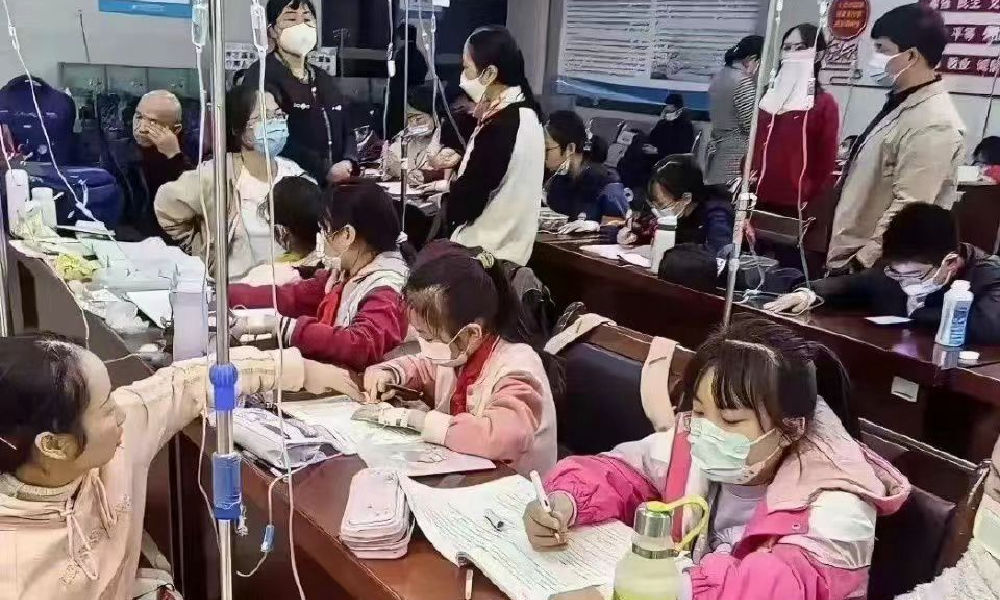
In the early morning of November 21, parents are already queuing up at Xi’an Children’s Hospital with their sons and daughters. It’s not even the line for a doctor’s appointment, but rather for the removal of IV needles.
The scene was captured in a recent video, only one among many videos and images that have been making their rounds on Chinese social media these days (#凌晨的儿童医院拔针也要排队#).
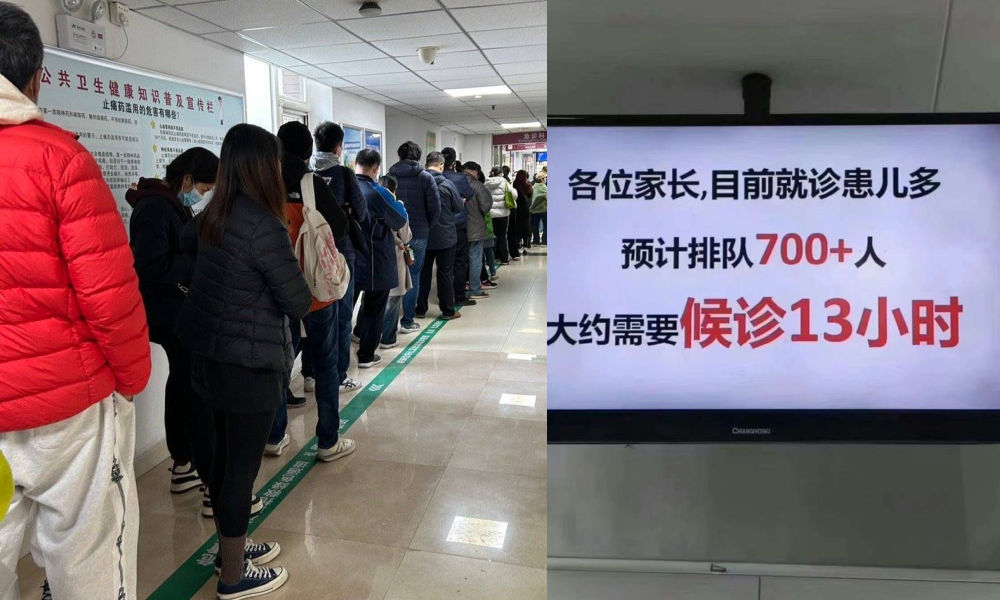
One photo shows a bulletin board at a local hospital warning parents that over 700 patients are waiting in line, estimating a waiting time of more than 13 hours to see a doctor.
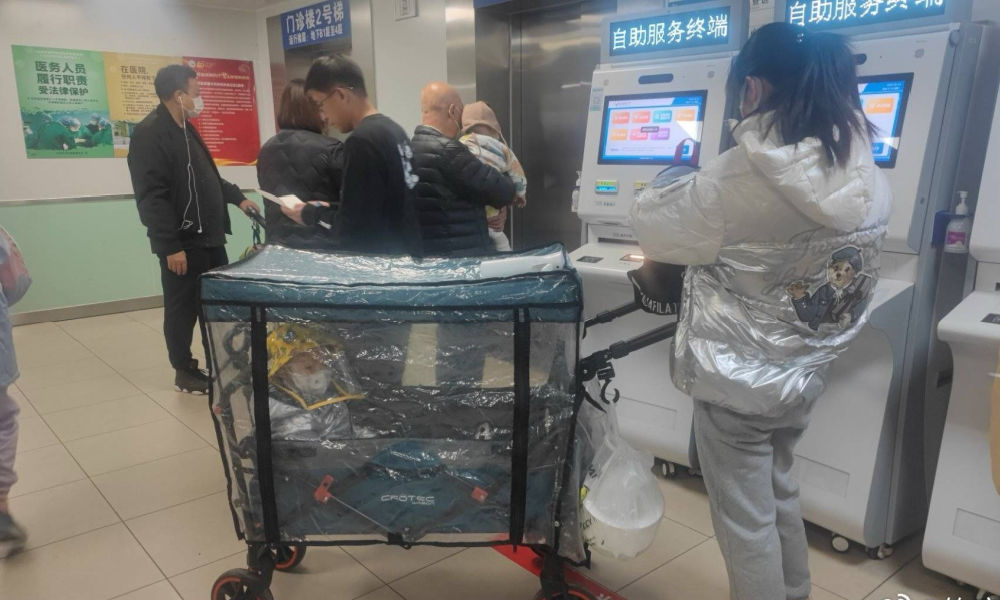
Another image shows children doing their homework while hooked up on an IV.

Recent discussions on Chinese social media platforms have highlighted a notable surge in flu cases. The ongoing flu season is particularly impacting children, with multiple viruses concurrently circulating and contributing to a high incidence of respiratory infections.
Among the prevalent respiratory infections affecting children are Mycoplasma pneumoniae infections, influenza, and Adenovirus infection.
The spike in flu cases has resulted in overcrowded children’s hospitals in Beijing and other Chinese cities. Parents sometimes have to wait in line for hours to get an appointment or pick up medication.
According to one reporter at Haibao News (海报新闻), there were so many patients at the Children’s Hospital of Capital Institute of Pediatrics (首都儿科研究所) on November 21st that the outpatient desk stopped accepting new patients by the afternoon. Meanwhile, 628 people were waiting in line to see a doctor at the emergency department.
Reflecting on the past few years, the current flu season marks China’s first ‘normal’ flu peak season since the outbreak of Covid-19 in late 2019 / early 2020 and the end of its stringent zero-Covid policies in December 2022. Compared to many other countries, wearing masks was also commonplace for much longer following the relaxation of Covid policies.
Hu Xijin, the well-known political commentator, noted on Weibo that this year’s flu season seems to be far worse than that of the years before. He also shared that his own granddaughter was suffering from a 40 degrees fever.
“We’re all running a fever in our home. But I didn’t dare to go to the hospital today, although I want my child to go to the hospital tomorrow. I heard waiting times are up to five hours now,” one Weibo user wrote.
“Half of the kids in my child’s class are sick now. The hospital is overflowing with people,” another person commented.
One mother described how her 7-year-old child had been running a fever for eight days already. Seeking medical attention on the first day, the initial diagnosis was a cold. As the fever persisted, daily visits to the hospital ensued, involving multiple hours for IV fluid administration.
While this account stems from a single Weibo post within a fever-advice community, it highlights a broader trend: many parents swiftly resort to hospital visits at the first signs of flu or fever. Several factors contribute to this, including a lack of General Practitioners in China, making hospitals the primary choice for medical consultations also in non-urgent cases.
There is also a strong belief in the efficacy of IV infusion therapy, whether fluid-based or containing medication, as the quickest path to recovery. Multiple factors contribute to the widespread and sometimes irrational use of IV infusions in China. Some clinics are profit-driven and see IV infusions as a way to make more money. Widespread expectations among Chinese patients that IV infusions will make them feel better also play a role, along with some physicians’ lacking knowledge of IV therapy or their uncertainty to distinguish bacterial from viral infections (read more here)
To prevent an overwhelming influx of patients to hospitals, Chinese state media, citing specialists, advise parents to seek medical attention at the hospital only for sick infants under three months old displaying clear signs of fever (with or without cough). For older children, it is recommended to consult a doctor if a high fever persists for 3 to 5 days or if there is a deterioration in respiratory symptoms. Children dealing with fever and (mild) respiratory symptoms can otherwise recover at home.
One Weibo blogger (@奶霸知道) warned parents that taking their child straight to the hospital on the first day of them getting sick could actually be a bad idea. They write:
“(..) pediatric departments are already packed with patients, and it’s not just Mycoplasma infections anymore. Cases include influenza, Covid-19, Norovirus, and Adenovirus. And then, of course, those with bad luck are cross-infected with multiple viruses at the same time, leading to endless cycles. Therefore, if your child experiences mild coughing or a slight fever, consider observing at home first. Heading straight to the hospital could mean entering a cesspool of viruses.”
The hashtag for “fever” saw over 350 million clicks on Weibo within one day on November 22.
Meanwhile, there are also other ongoing discussions on Weibo surrounding the current flu season. One topic revolves around whether children should continue doing their homework while receiving IV fluids in the hospital. Some hospitals have designated special desks and study areas for children.
Although some commenters commend the hospitals for being so considerate, others also remind the parents not to pressure their kids too much and to let them rest when they are not feeling well.
Opinions vary: although some on Chinese social media say it's very thoughtful for hospitals to set up areas where kids can study and read, others blame parents for pressuring their kids to do homework at the hospital instead of resting when not feeling well. pic.twitter.com/gnQD9tFW2c
— Manya Koetse (@manyapan) November 22, 2023
By Manya Koetse, with contributions from Miranda Barnes
Get the story behind the hashtag. Subscribe to What’s on Weibo here to receive our newsletter and get access to our latest articles:
Spotted a mistake or want to add something? Please let us know in comments below or email us. First-time commenters, please be patient – we will have to manually approve your comment before it appears.
©2023 Whatsonweibo. All rights reserved. Do not reproduce our content without permission – you can contact us at info@whatsonweibo.com.
What’s on Weibo Chapters
Subscribe

Five Trending Proposals at the Two Sessions 🔍

US-Russia Rapprochement and “Saint Zelensky”: Chinese Online Reactions to Trump’s Shake-Up

“Li Jingjing Was Here”: Chinese Netizens React to Rumors of “Chinese Soldiers” in Russian Army

How Ne Zha 2’s Shen Gongbao Became Known as the Ultimate “Small-Town Swot”

Beyond the Box Office: What’s Behind Ne Zha 2’s Success?

Our Picks: Top 10 Chinese Buzzwords and Phrases of 2024 Explained

“Dear Li Hua”: The TikTok/Xiaohongshu Honeymoon Explained

Why Chinese Hit Movie “Her Story” is ‘Good Stuff’: Stirring Controversy and Celebrating Female Perspectives

Chiung Yao’s Suicide Farewell Letter: An English Translation

12-Year-Old Girl from Shandong Gets Infected with HPV: Viral Case Exposes Failures in Protecting Minors

Weibo Watch: Christmas in China Is Everywhere and Nowhere

Breaking the Taboo: China’s Sanitary Pad Controversy Sparks Demand for Change

Weibo Watch: A New Chapter

Weibo Watch: China’s Online Feminism Is Everywhere

Story of Chinese Female MA Graduate Going Missing for 13 Years Sparks Online Storm
Get in touch
Would you like to become a contributor, or do you have any tips or suggestions? Get in touch here!
Popular Reads
-
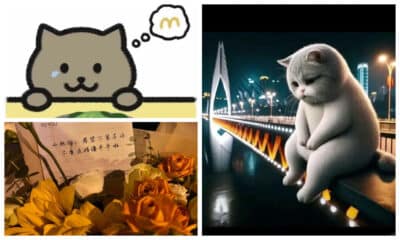
 China Insight10 months ago
China Insight10 months agoThe Tragic Story of “Fat Cat”: How a Chinese Gamer’s Suicide Went Viral
-

 China Music11 months ago
China Music11 months agoThe Chinese Viral TikTok Song Explained (No, It’s Not About Samsung)
-

 China Digital9 months ago
China Digital9 months agoChina’s 2024 Gaokao Triggers Online Discussions on AI
-

 China Arts & Entertainment10 months ago
China Arts & Entertainment10 months agoSinging Competition or Patriotic Fight? Hunan TV’s ‘Singer 2024’ Stirs Nationalistic Sentiments





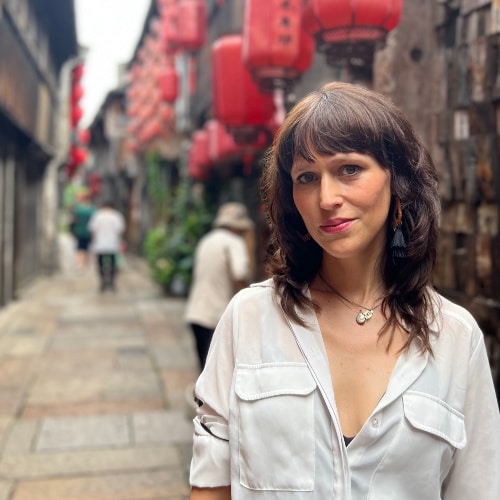
Guest
July 1, 2022 at 8:44 am
I worked in hospitals, and even by Chinese standards these places have nothing in common with a hospital. They should be called what they are: prisons.